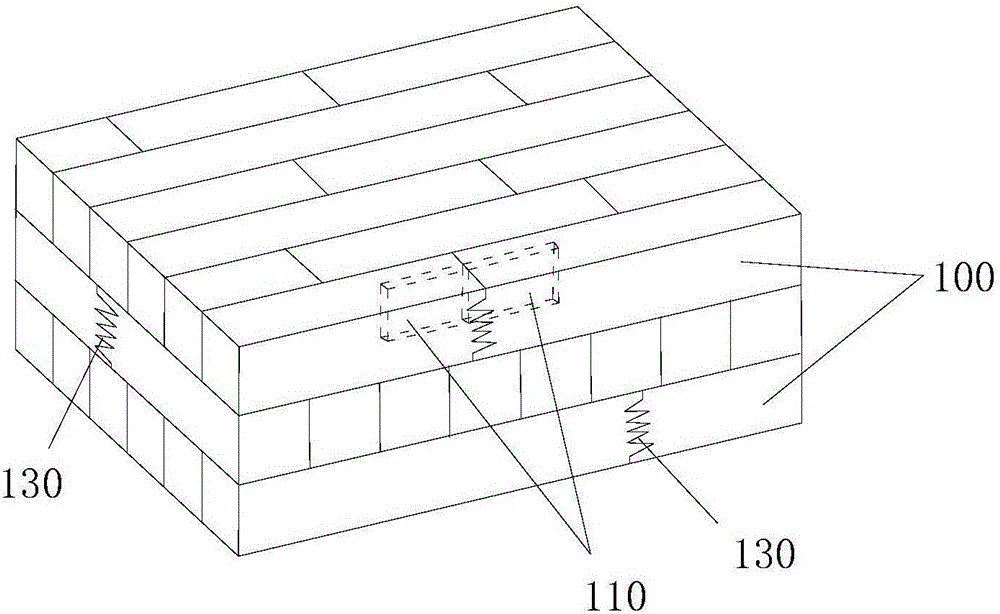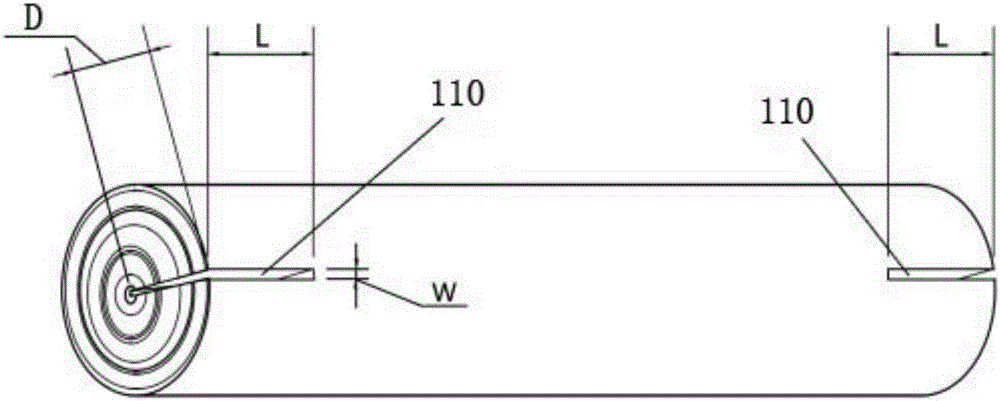Cross laminated wood structure and manufacture method
A manufacturing method and technology for laminated timber, applied in the field of wood processing, can solve the problems of low strength and poor stability, and achieve the effects of increasing the yield of wood, high dimensional stability, and improving drying efficiency
- Summary
- Abstract
- Description
- Claims
- Application Information
AI Technical Summary
Problems solved by technology
Method used
Image
Examples
Embodiment 1
[0069] The cross-laminated timber in this embodiment is made by interlacing and pressing finger-joined boards, wherein the finger-joined laminates are made of eucalyptus small-diameter logs for slotting and drying, and refer to Figure 4 The material is cut by sawing, and the obtained wood strips 100 are joined by end finger joints and parallel splicing on the sides, and the stress relief grooves 110 are retained in the finger joint boards on the surface of the cross-laminated timber.
[0070] The specific preparation steps of the finger joint board are:
[0071] 1) Material selection: Select fast-growing eucalyptus logs to prepare the raw materials for cross-laminated timber finger-bonded laminates according to requirements. Use a rotary cutter to round the logs to remove the branches. The diameter of the logs is 8.5 cm to 9.5 cm. After round, the diameter of the round timber is 8 cm to 9 cm, and the length is 600 mm to 800 mm.
[0072] 2) Opening the stress relief groove 110: draw ...
Embodiment 2
[0081] The specific preparation steps of the finger joint board are:
[0082] 1) Material selection: Select fast-growing eucalyptus logs according to requirements to prepare the raw materials for cross-laminated timber finger-bonded laminates. Use a rotary cutter to round the logs to remove branches. The diameter of the logs is 9.5 cm to 11.5 cm. The diameter of the round timber is 9 cm to 11 cm, and the length is 800 mm to 1000 mm.
[0083] 2) Opening the stress relief groove 110: draw stress relief grooves 110 with a length of 10% of the length of the round material at each end of the required dry round material, the length is 10 cm, the direction of the stress relief groove 110 passes through the marrow core, and the depth is 3 Cm, the width is 3 mm.
[0084] 3) Drying: Choose a well-ventilated place without sun exposure to dry the round timber naturally to a moisture content of 45%; then stack the round timber into the drying kiln at a temperature of 50°C to 70°C and a relative ...
Embodiment 3
[0092] The specific preparation steps of the finger joint board are:
[0093] 1) Material selection: select fast-growing eucalyptus logs to prepare the raw materials for cross-laminated timber finger-bonded laminates according to requirements. Use a rotary cutter to round the logs to remove branches. The diameter of the logs is 11.5 cm to 12.5 cm. The diameter of the round timber is 11 cm to 12 cm, and the length is 1000 mm to 1200 mm.
[0094] 2) Opening stress relief grooves 110: draw stress relief grooves 110 with a length of 10% of the length of the round material at each end of the required dry round material, the length is 10 cm, the direction of the stress relief groove 110 passes through the marrow core, and the depth is 3.5 Cm, the width is 4 mm.
[0095] 3) Drying: Choose a well-ventilated place without sun exposure to dry the round timber naturally to a moisture content of 45%; then stack the round timber into the drying kiln at a temperature of 50°C to 70°C and a relativ...
PUM
| Property | Measurement | Unit |
|---|---|---|
| thickness | aaaaa | aaaaa |
| width | aaaaa | aaaaa |
| length | aaaaa | aaaaa |
Abstract
Description
Claims
Application Information
 Login to View More
Login to View More - R&D
- Intellectual Property
- Life Sciences
- Materials
- Tech Scout
- Unparalleled Data Quality
- Higher Quality Content
- 60% Fewer Hallucinations
Browse by: Latest US Patents, China's latest patents, Technical Efficacy Thesaurus, Application Domain, Technology Topic, Popular Technical Reports.
© 2025 PatSnap. All rights reserved.Legal|Privacy policy|Modern Slavery Act Transparency Statement|Sitemap|About US| Contact US: help@patsnap.com



